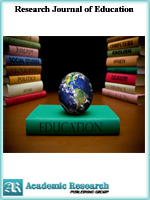Research Journal of Education
Online ISSN: 2413-0540
Print ISSN: 2413-8886
Print ISSN: 2413-8886
Quarterly Published (4 Issues Per Year)

Archives
Volume 4 Number 1 January 2018
How do Teacher Preparation and Infrastructural Facilities Impact on The Implementation of Lower Basic Education Curriculum in Nigeria?
Authors: Emmanuel E. Achor ; Benjamin O. Olokwu ; Esther O. Ejeh
Pages: 12-25
Abstract
This study is an assessment of the implementation of Lower Basic Education curriculum in Idah Education zone of Kogi State. The expost facto design study was guided by seven research questions and 5 hypotheses. A sample of 376 (208 from public schools and 168 from private schools) Lower Basic Education (LBE) teachers were used from Idah Education Zone comprising of Ibaji, Idah and Igalamela-Odolu LGAs. Two instruments were used in this study are (a) Availability and Adequacy of Infrastructural Facility Scale (AAIFS) and (b) Basic Education Implementation Variables Questionnaire (BEIVQ). The reliability coefficient of the AAIFS is 0.88 for availability and 0.91 for adequacy while that of the BEIVQ is 0.83. The hypotheses were tested at 0.05 level of significance. Following data analysis the following findings were made: (1). It was found that only three infrastructural facilities out of 20 listed were available and they are play field, teachers’ book and First Aid Box. Those that were not available include Class Rooms, Admin blocks, Science corner/mini Lab, Wall charts, Staff Offices, Audio aids (eg radio, TV), Motion aids, Stores, Desks and chairs, Projector, Library, Computer/Lap tops, Internet facility, Source of Electricity, Studios, Toilet facilities and Water source. (2). It was also found that teacher preparation for implementation of LBE in Idah education zone of Kogi State is adequate. Specifically it was found that qualified teachers are engaged and adequate in number; teachers go on seminars and workshops regularly though mostly through self efforts, newly recruited teachers are mentored by older teachers at an informal level and recruitment of teachers is through rigorous interview. Teachers are motivated and evaluation for promotion of teachers involves some practical observation in class. (3). However, there is no significant difference between the mean level of teacher preparation for LBE curriculum in public and private schools (4). It was also found that funding is inadequate for implementation of LBE curriculum. Thus, there is no significant difference between the mean level of funding of LBE curriculum in public and private schools. (5). There is a significant difference between the mean level of supervision/ monitoring and availability of infrastructural facilities for curriculum implementation of LBE. Similarly, there is significant difference between the mean level of adequacy of supervision/monitoring of LBE curriculum in public and private schools. In general supervision of LBE curriculum in Idah Education zone of Kogi State is poor, haphazardly done and mostly handled by inexperienced teachers. (6). It is also found that the challenges to effective implementation of LBE curriculum in the study area are frequent strike action by teachers, poor teacher motivation, non regular payment of teachers’ salary, inadequate funding, outdated textbooks and inadequate teaching materials. It was recommended among others that provision of infrastructural facilities for LBE curriculum implementation should be improved by encouraging individuals and non-governmental organizations to partner with government in provision of essential materials.
The Way Forward: Reviewing an Interior Design Curriculum in the United Arab Emirates
Authors: Isra AbuZayed ; Solomon Arulraj David
Pages: 1-11
Abstract
According to Dubai’s Design and Fashion Council’s (DDFC) Design Outlook Report 2016, the MENA region will require approximately 30,000 design graduates by the year 2019. This number is nine times the existing amount of design graduations currently produced annually (DDFC 2016). Therefore, the design education industry is continually growing and becoming very competitive. In the UAE, there are currently 11 institutes, which deliver a bachelor’s degree in interior design. The aim of this paper is to bring forth recommendations to innovate and enhance an existing interior design program at a leading university in Dubai to set it apart from the competition. Utilizing a positivists (realism) approach to be able to determine the necessary reform required for the interior design program through the content analysis of a) relevant literature review, b) review and analysis of two program accreditation bodies, and c) reviewing two of the top five programs of interior design. An analysis of the findings was formed followed by a comparison to the existing interior design program at the selected university then resulted in three conclusions: 1. Improvement of the learning environment and the collaborative project work both within the institution and internationally. 2. Incorporate effective teaching methodology to enhance the student’s visualization skills through converging and assimilating teaching methodologies. 3. Additional specialization courses to increase the percentage of design course output in the curriculum while additionally incorporating sustainable design within interior design program.



